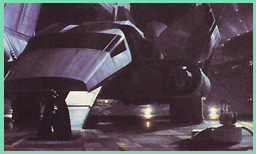Glass painting became an important tool of movie makers. By 1916 cinematographer Paul Eagler and artist Irving Martin combined the principles of the glass shot and the matte-and-countermatte system at the Thomas H. Ince Studio, enabling the artist to add his work to the scene at a more convenient time. By the late 1920s such techniques were commonplace and the so-called matte painter became a vital member of any special effects team. With the proliferation of the science-fiction film in recent years, matte paintings are more important than ever before.
Some of the fine matte artists of today are men of long experience in this highly specialized field. Others are young men who have learned by studying the works of the masters and are now bringing ideas of their own into the films. The matte painting and matte photography departments at Industrial Light and Magic are made up of five young men. Michael Pangrazio is the matte painting supervisor, Chris Evans and Frank Ordaz are matte artists, Neil Krepela is matte camera supervisor, and Craig Barron is matte cameraman. The work of this group in Return of The Jedi constitutes some of the most sophisticated matte technique that has reached the screen.
Pangrazio did his first professional matte paintings for Introvision, in Hollywood, about seven years ago. Two years later he joined ILM, assisting Harrison Ellenshaw and Ralph McQuarry with the matte paintings for The Empire Strikes Back. Later he worked with Alan Maley, chief matte painter for Raiders of the Lost Ark and Dragonslayer. Evans and Ordaz, both under 30, have also achieved their high degree of professionalism during a few years of concentrated work at ILM.
Krepela began his movie career making a documentary news film in the Midwest. He came to San Francisco and teamed up with some friends doing opticals and animation, partly with equipment he designed. When ILM moved to the area, Krepela was hired to build equipment. A short time later he set up the matte photography department. Barron, who is from Berkeley, also was hired at ILM because of his ability to modify camera equipment and a knowledge of animation. His ILM career began with Empire.
Return of the Jedi was still in production when Pangrazio, Krepela and Barron discussed their work for American Cinematographer.
"We used every means available to us," Pangrazio said. "Front projection, rear projection, original negative latent image, optical printing or whatever else works best for the shot. When we can, we composite them in our own department. Sometimes, if we have a large part of the frame that has to be reproduced and duped, we'll send it to the optical department because they can get better quality than we do. And sometimes there are other elements to be put into it—blue screen elements, for example, in which case our painting could be just one of many elements that have to go together, and we really can't do that as easily as optical can. Sometimes we have to get opticals to make a reduction of some element. We've sent about 30 to 40 per cent of our shots through opticals on this show. The rest we composite here through various means.
"Generally we use whatever works out best for the shot. Each one has its own needs and problems. I think the only kind we didn't have this time was a glass shot. We were actually going to do one, but it didn't work out."
Most of the equipment used in compositing and photographing the mattes is unique, having been constructed especially for the department.
Krepela described the new Automatte camera, which was designed at ILM. "It is totally motion controlled. It'll shoot VistaVision, 1:85 or any flat 35mm format. It also shoots anamorphic 35mm with a special lens we built. The first show we really used it on was E.T.
"There's a 24 foot track, a very heavy, rigid thing which is mounted into the floor. The artwork is carried by two moving planes that move X, Y and Z like an animation stand, and the camera also moves X, Y and Z. Plus, it rolls. Originally we thought that the camera would be used on only a few really nice shots where we could take our time, but on this show it's turned out that the majority of paintings ended up on this system because it's very flexible and we can put in a lot of moves with it.
[ continued on page 2 ]
